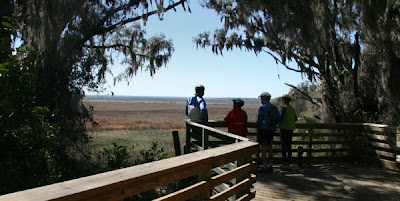
 Not very many bicycling venues contain a message warning of free ranging bisons and alligators but the one pictured above near Gainesville, FL clearly did. Below that, my biking companions Ted Kmet, (left) Lynn Rush, George Kmet and Becky Minnick enjoy a peek at the vastness of Payne’s Prairie which does, indeed, contain a small heard of bisons and absolutely countless alligators.
Not very many bicycling venues contain a message warning of free ranging bisons and alligators but the one pictured above near Gainesville, FL clearly did. Below that, my biking companions Ted Kmet, (left) Lynn Rush, George Kmet and Becky Minnick enjoy a peek at the vastness of Payne’s Prairie which does, indeed, contain a small heard of bisons and absolutely countless alligators.21,000 ACRES OF WILD—
The prairie basin and surrounding uplands have been a center of human activity dating to 12,000 years ago. It was the site of the largest cattle ranch in Spanish Florida in the 1600s. Seminole Indians were the native inhabitants in the 1700s.
In 1871 rains flooded the basin and for a few years Alachua Lake there supported the use of steam powered boats for human and merchandise transportation. In 1891 Alachua sink, the main drain for the basin, became unclogged and by 1892 the marsh character of the basin had returned.
Today, Payne’s Prairie, Florida’s first state preserve, is designated as a national, natural landmark. It hosts more than 270 species of birds. Small herds of American Bisons were reintroduced in the 1970s in an effort to restore the area to pre-European settler conditions.
And, in the relatively small area we were able to explore, the visible alligators were truly countless.
They were mostly docile appearing in the warm sub-tropical sun but they were wild beasts in their native habitat unfettered by any man-made barrier.
Visitors freely roamed within fathoms of these creatures that were mostly slumbering on the watercourse banks or partially submerged in vast pads of aquatic weeds.
They were everywhere, and, on closer examination, everywhere more.
I was concentrating on doing an alligator portrait with my most powerful lens when the three behemoths of my attention exploded from their slumber in a mini-maelstrom of thundering water—and disappeared.
They disappeared before I was able to engage my aging bones in a successful retreat.
I was very grateful it was some other critter that had attracted their violent attention.
Local resident and our host for the week’s visit, Ted Kmet, told of once walking one of the trails with his way suddenly blocked by a large gator. He wisely reversed course to give the creature its space—and encountered another one slowly crossing the trail behind him. Patience rewarded him with safety.
The prairie is a place of marvelous natural beauty but visitors are well advised to beware.
Alligators have 80 teeth. More than a million of them were recorded in a 2006 Florida census. Males can exceed 15 feet in length and weigh 800 pounds or more. They are capable of short sprints in excess of 30 mph.
Pay attention!
I usually struggle to achieve 30 mph on my bicycle.



 Please stop by!
Please stop by!










